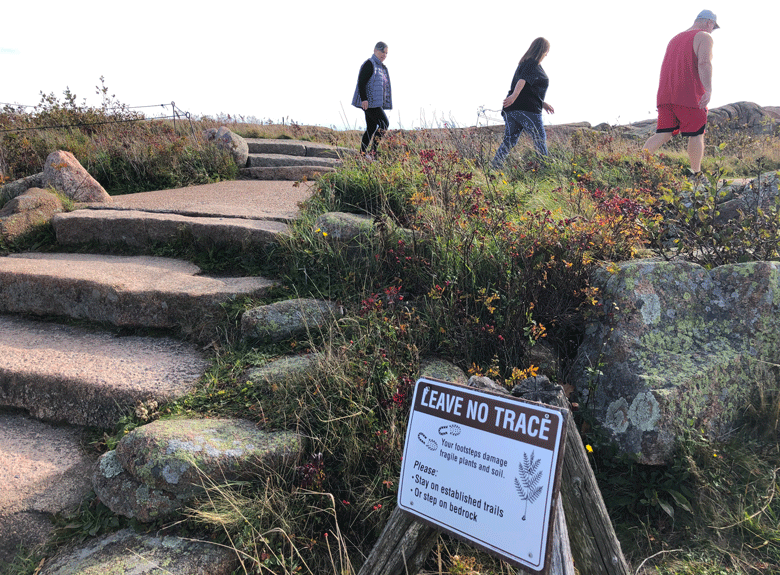Natural scientists couldn’t ask for a more accessible, varied, and dynamic subject to study than Acadia National Park. And, of course, it’s a beautiful place to work.
Some of the scientists examining this changing landscape presented their work at the Schoodic Institute’s Acadia National Park Science Symposium on Oct. 19, with work ranging from birds in spruce trees to a blocked-up cove.
“Rapid change in Acadia has not stopped during the pandemic,” said Nick Fisichelli, Schoodic Institute’s president and CEO, at the opening of the conference.
“We certainly have an uncertain future for our spruce trees.”
The park as living laboratory comes with substantial human interaction—some four million visit each year, reported park superintendent Kevin Schneider. One area where human impact is being studied and modified is on the trails at the summit of Cadillac Mountain.
John Daigle, an associate professor at the University of Maine who works in its parks, recreation, and tourism program, said his study prompted the use of signs alerting the public to the sparse and vulnerable vegetation on the mountain. One sign included the phrase
“Plants grow by the inch and die by the foot.”
While “Leave No Trace” signs with a line crossing through the image of a foot are effective, Daigle said the best approach was to block access to vegetated areas with ropes and barriers.
One suggestion that emerged from the research was to reorient trails to face the sunrise and sunsets, because those events often drew visitors off existing trails.
A bit of Acadia’s history emerged in an ongoing environmental dilemma. Otter Cove, a landmark because the Park Loop Road is carried over it via a stone causeway, is suffering because of the lack of water flowing in and out.
Presenters said the causeway was built in 1939 in part to create a swimming pool for locals to draw them away from areas enjoyed by the wealthy “rusticators.” The pool was never completed, and so today, three stone arches in the causeway allow tides to flow in and out—but not enough.
Another factor contributing to the poor environmental health of the cove is the legacy of a sewer treatment plant that operated upstream from 1976 to 1997. The outflow pipe was supposed to extend beyond the causeway but instead dumped into the intertidal zone, presenters said.
Clams have not been found in the cove, though invasive green crabs have been seen. Locals continue to be engaged, with many hoping to redesign the causeway to allow more significant tidal flow.
Jay Wason of UMaine’s School of Forest Service told the story of a spruce tree he named RD85. A photograph from 1940 depicted the subject tree, which he said died 50 years ago and now lies on the forest floor, covered in moss.
Though spruce dominated the coastal environment for the last 2,000 years, he said oak was the species most found here from 10,000 to 6,000 years ago. Spruce regeneration requires cool and moist conditions, Wason said, and those conditions held sway from 1850 to 2000. Spruce bud worm took a toll in the 1920s, and a general decline was noted from the 1940s through the 1970s.
The severe drought conditions this summer from Kittery to Rockland will slow spruce growth next year, he added.
The future does not look good, either, according to models. By 2060, “We will have no suitable habitat for red spruce,” Wason said, and accelerating warming will further impact the trees.
“We certainly have an uncertain future for our spruce trees,” he said. “I think we will have red spruce tree along the coast of Maine in a hundred years,” but where they will survive and thrive is not clear.
At the conference’s opening, Schoodic Institute’s Catherine Schmitt noted that “Acadia has this incredible legacy of science,” going back to before its founding, and that a historical baseline for seascape and forestry is available.
Bik Wheeler of the National Park Service drew on that history in his work on bird behavior. In 1957, Robert MacArthur studied how different species of warblers would forage at different heights on spruce trees at Bass Harbor.
“They were actually partitioning the resources,” Wheeler said. Now, that behavior is less defined.
“Behavior is plastic,” Wheeler concluded.
Seth Benz, director of bird ecology at the Schoodic Institute, presented on diversity of species such as ants, spiders, and birds on the Schoodic Peninsula.
“It’s a transition zone,” he said, between southern deciduous and northern coniferous, creating a dynamic environment.
With phone-based apps like iNaturalist, data is more readily available. Some 252 bird species have been documented on the peninsula, and in the period from Sept. 1 to Nov. 30, 105,000 migratory birds pass through, he said.
But the news isn’t all good. Since 1971, winter bird populations have declined on the peninsula by 43%.





